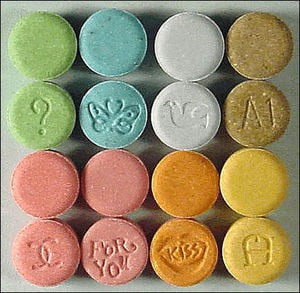Sixty milligrams, a pill barely bigger than the tip of your pinky, can work like and anti-depressant, putting a person in a great mood in a hurry. It isn’t addictive and is being used in medical research, but one hit of it has the potential to kill you.
It’s an increasingly popular drug known as ecstasy, or, more commonly, X. While many scientists and doctors argue that it may actually be beneficial, it’s been proven that, if after effects of this drug don’t kill you, they can and most likely will leave you with serious health problems for the rest of your life.
Ecstasy, often taken in 60 or 10 milligram hits, affects the body’s levels of serotonin, a chemical in the brain that regulates emotional highs and lows. It can create a feeling of euphoria and make a person feel intensely bonded with everything around them, often turning people into sexual dynamos. Hence, it has been dubbed “the love drug.”
However, after these happy feelings and hallucinations wear off, they’re typically replace by more disturbing ones, accompanied by sweating, chills, vomiting, fever, and extreme thirst. After taking ecstasy, many people die from hyponatremia (drinking too much), fatally high fevers, strokes, cardiac arrest, or seizures. And even if you do live through that, the long-term effects of using ecstasy will come back to bit you years later.
The National Institute of Drug Abuse (NIDA) has done studies on the short- and long-term effects of using ecstasy by administering it to monkeys. As much as six years later, monkeys who received only two 60-milligram hits of ecstasy total were found to have sleeping problems, diminished thought capacity, memory loss, and permanent brain damage. All the same symptoms have been found in human users, along with tendencies to develop severe depression and problems with sexual function.
Still, some argue that the drug can be used to help psychiatric patients deal with their emotional scars, particularly people with post-traumatic stress disorder (commonly referred to as PTSD). In a 2004 article in the Baltimore Sun, “Debate Over Ecstasy’s Uses,” Rick Doblin, the Director of the Multidisciplinary Association of Psychedelic Studies (MAPS), said, “[Ecstasy] makes people feel comfortable with themselves. It brings them into the moment. With PTSD, people are trapped in the past.”
MAPS is a non-profit group that funds research done on the medical benefits of ecstasy. Dobin himself is not a doctor or a scientist, but has taken ecstasy over 100 times.
Researchers say that the reason that ecstasy on the street can be fatal because it is often laced with other drugs such as LSD, ephedrine, and crystal meth. In controlled laboratories, study members are given very small, untainted amounts of ecstasy that are intended to create results and yet are weak enough not to be harmful. However, these hits of ecstasy often induced fatally high fevers in participants.
In 2001, over 8 million Americans ages 12 up reported having used ecstasy at least once in their life. In 1999, the number of reported ecstasy-related emergency room visits jumped from 253 to 4,026. The drug was made illegal in 1986, except for use in government-approved medical studies.
So far, no one has been able to prove that ecstasy has any lasting, legitimate medical benefits. The plain and simple fact is that it can kill you, quickly and easily. All it takes is one hit.
Sources:
Kohn, David. “Debate Over Ecstasy’s Uses.” The Baltimore Sun. August 2, 2004.
The National Institute of Drug Abuse: www.nida.nih.gov
United States Department of Health and Human Services: www.oas.samhsa.gov/
Ecstasy.org: www.ecstasy.org

